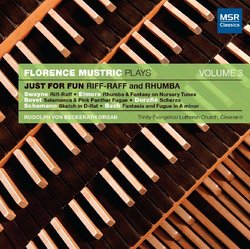| All Artists: Florence Mustric Title: Just For Fun - Riff-Raff and Rhumba: Florence Mustric Plays, Volume 3 (Rudolph von Beckerath Organ) Members Wishing: 0 Total Copies: 0 Label: MSR Classics Release Date: 11/9/2010 Genre: New Age Style: Instrumental Number of Discs: 1 SwapaCD Credits: 1 UPC: 681585127223 |
Search - Florence Mustric :: Just For Fun - Riff-Raff and Rhumba: Florence Mustric Plays, Volume 3 (Rudolph von Beckerath Organ)
 | Florence Mustric Just For Fun - Riff-Raff and Rhumba: Florence Mustric Plays, Volume 3 (Rudolph von Beckerath Organ) Genre: New Age
Mentally and physically, an organist s brain and hands and feet must manage all those details. Psychologically, the organist lives in the shadow of the immortal Bach. All that conspires to make the organist s lot a serious... more » |
Larger Image |
CD Details
Synopsis
Product Description
Mentally and physically, an organist s brain and hands and feet must manage all those details. Psychologically, the organist lives in the shadow of the immortal Bach. All that conspires to make the organist s lot a serious one. Well, it s time to have some fun! We dive in with Robert Elmore s dazzling Rhumba, with its sizzling melodies and tight rhythms. Dedicated to virtuoso Claire Coci, Elmore s Rhumba is a tour de force for the feet. They are not to be outdone by the hands! The feet play glissandi, chords, and the melody in the laidback middle section. Elmore was organist for the Philadelphia Orchestra, which performed some of his works. Salamanca was born as an improvisation at the Cathedral of Salamanca, Spain. To thank the custodians for working long hours during a week of music events, Guy Bovet asked them to give him the subject for his improvisation at the final concert. Salamanca begins with piccolo and drum effects, segues into classical Spanish organ styles, and ends with a flourish of the matador s cape. Olé! Fugue on Henry Mancini s Pink Panther theme began as an improvisation at a Bach Society concert (to add an element of surprise, he redundantly titled this Fugue on a Subject). Bovet slyly tweaks the Pink Panther theme. Could the humor of some of Bovet s music be compensation for the seriousness of his two specialties, the Spanish Baroque era and the music of Jehan Alain? For pure fun, it s hard to beat Robert Elmore s Fantasy on Nursery Tunes. We hear four tunes: Three Blind Mice, followed by Twinkle, Twinkle, Little Star (adorned by the cymbalstern, a set of untuned bells), next by London Bridge Is Falling Down, and then by Pop Goes the Weasel. Finally, Elmore combines all the tunes for a madcap finish. For fun from the player s perspective, it s hard to top a boogie-woogie bass played by the feet. That s just one of the many attractions in Giles Swayne s Riff-Raff, composed in 1983. A cross-over work, Riff-Raff draws on non-classical styles. Swayne exploits idiosyncrasies of the organ in savvy and imaginative ways. He occasionally ignores human limitations at times, two hands and two feet are barely enough. In the world of jazz, a riff is an ostinato, or repeating pattern, that accompanies a solo. Riff-Raff is a kaleidoscope of riffs and rhythms. Swayne usually sets up his riffs gradually, so you can hear them develop layer by layer. Some riffs return, perhaps in new combinations. A few riffs surface briefly, then vanish. The music builds to a climax, drops back, and builds again. Gradually, the build-ups come faster and more insistently. Riff-Raff begins with short chords that burst unpredictably, ranging in dynamics from fortissimo to an echo of an echo. When the sound-bursts return, Swayne pits their unpredictability against their total opposite a strong rhythmic ostinato in the Pedal line. Finally, the soundbursts occur alone again, to end Riff-Raff. The totally elegant Scherzo by Maurice Duruflé is as French and as light as a successful soufflé. Duruflé had such exacting standards that he released very few of his compositions for publication. This perfect concoction is his Opus 2! Robert Schumann composed four Sketches, or Skizzen, for pedal piano, an instrument which basically made it possible to practice organ music in the comfort of home. The last in the set, this whimsical Sketch in D-flat major, is the least pianistic and the most delightful of the four. J.S. Bach can be great fun to listen to and even greater fun to play. So I wrap this CD with the Fantasia and Fugue in A minor (S. 561), an early Bach work whose repeated patterns and echoes juxtapose nicely with Riff-Raff. Scholars now say the Fantasia and Fugue in A minor is not the work of Bach, but I cannot imagine a likelier composer.

 Track Listings (8) - Disc #1
Track Listings (8) - Disc #1